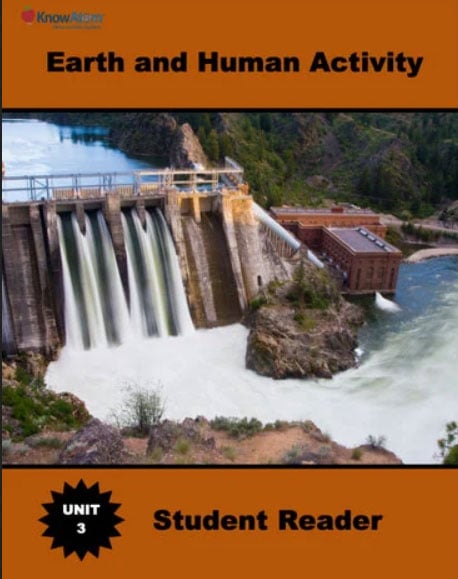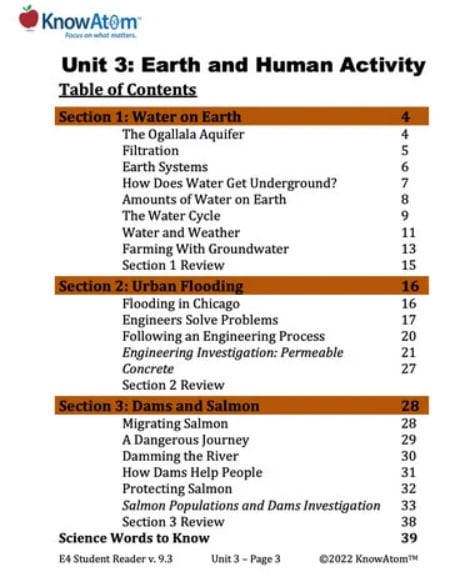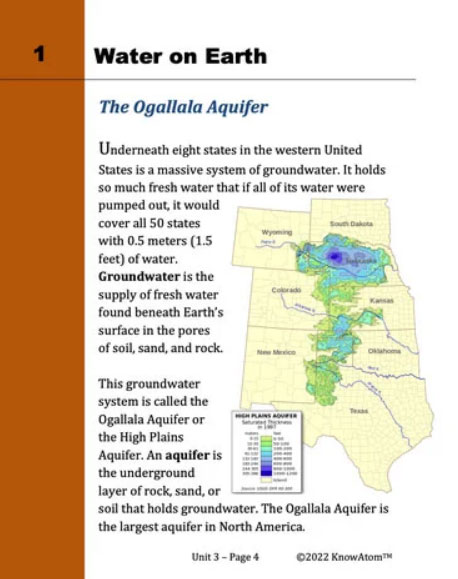The science background section provides teachers with more in-depth information on the phenomena students explore in this unit. Below is an excerpt from the science background for this lesson on Earth materials and water flow.
The water in the Ogallala Aquifer is groundwater—the supply of fresh water found beneath Earth’s surface in the pores of soil, sand, and rock. The underground layer of rock, sand, or soil that holds groundwater is an aquifer. Groundwater isn’t an underground river, but a supply of water that fills the spaces between soil particles and rock.
Groundwater is the result of two interacting Earth systems: the hydrosphere and the geosphere. A system is a set of connected, interacting parts that form a more complex whole. Scientists study Earth’s systems to understand how the different parts interact with and influence one another. The hydrosphere is the system made up of all of the water found on Earth. The geosphere is made up of Earth’s landforms, including rocks and soil. As water moves over Earth’s surface, it shapes the geosphere as it weathers and erodes the rocks and soil it passes over.
The hydrosphere is also affected by the geosphere because not all rocks store water. The processes that shape and re-form rocks in the rock cycle determine how likely a rock is to store water.
Rocks that are both porous and permeable are most likely to hold water. Porosity refers to the number of spaces between particles in a substance. It determines how much water a material can hold. Permeability refers to the ease with which substances such as water move through a material. It determines whether water can move through the material.
Water on Earth is also constantly interacting with another Earth system: the atmosphere. The atmosphere is the mixture of gasses, dust, water vapor, and other molecules above Earth’s crust. When water falls to Earth’s surface from the atmosphere in the form of rain or snow, some of it absorbs into the ground, where it can become part of an aquifer.
Water also interacts with the biosphere, which is made up of all living things on Earth. All living things need water to survive. Plants absorb water through their roots and release it through their leaves as water vapor back to the atmosphere. The process by which water moves through plants from roots to their leaves is called transpiration. Plants can also access groundwater if their roots are deep enough to reach the water table—the highest point in an aquifer from which water can be obtained.
Water that doesn’t seep into the ground or get absorbed by plants or animals flows downhill because of gravity. The movement of water downhill on Earth’s surface is the largest source of weathering and erosion on the planet.
With enough energy from the sun, liquid water on Earth’s surface evaporates into the atmosphere. Evaporation is the process of liquid water changing into water vapor, its gas state. As the water vapor moves higher in the atmosphere, it loses heat. Eventually it will condense. When it condenses, it changes from a gas back into liquid water. Precipitation is water falling back to Earth’s surface in the form of rain, snow, sleet, or hail. Water that doesn’t immediately evaporate back into the atmosphere will collect into lakes, pools, and other water sources. Depending on how permeable Earth’s surface is, some water will seep underground.








